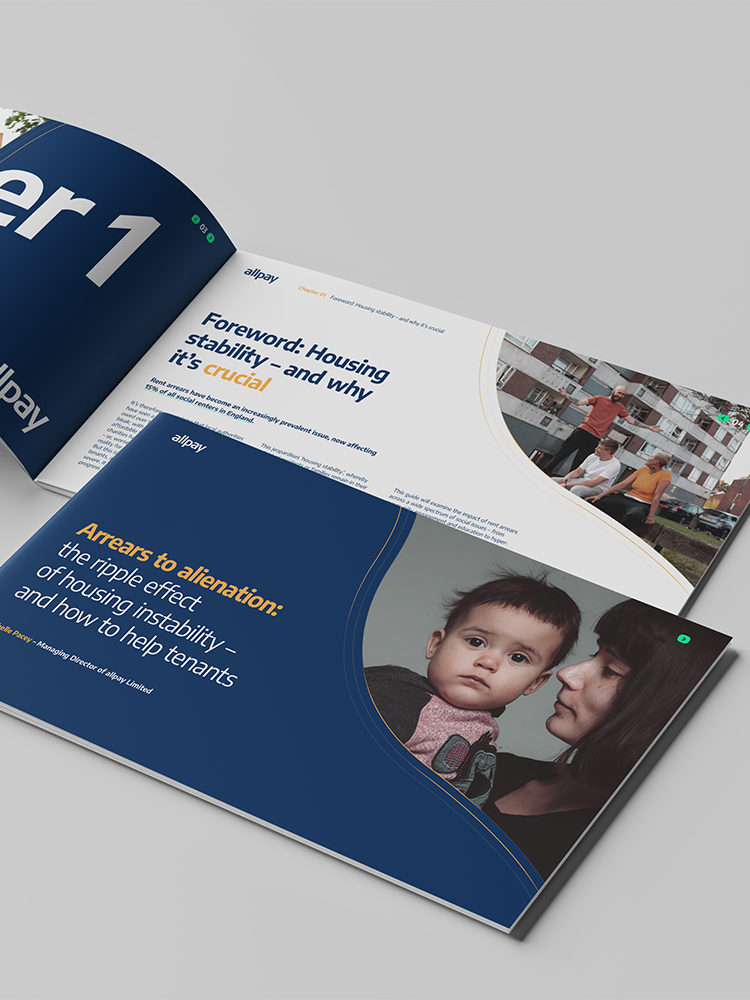Arrears to Alienation Report: The Ripple Effect of Housing Instability
The staggering recent increase in rental arrears has left many renters fearing eviction. That fear and instability has ripple effects on tenants, families and the communities they call home. In our report, we delve into the multifaceted nature of housing instability, its repercussions, and how to help.

Get the report
Read the report to understand more about the impact of rent arrears across a spectrum of social issues from educational attainment to mental health, and how to improve outcomes.
Report Download – Arrears to Alienation
Key themes covered in the report
Our report explores housing stability as a cornerstone of societal well-being. We examine the often-overlooked health concerns associated with hyper-mobility and the profound – and alarming – impact that housing instability can have on vulnerable tenants and their families’ life courses, such as their educational outcomes. We also highlight the vital social capital that comes with stable housing arrangements, and how housing authorities can help to improve tenants’ lives.
Read the report to uncover insights on…
- We’re exploring the detrimental effects of unstable housing and frequent moves, particularly on children’s health. We also examine the impact of housing insecurity on mental health and physical health, including links between temporary housing and food insecurity.
- We explore how maintaining the placement of families near schools, healthcare and community centres improves access to support networks and directly affects children’s educational attainment; ultimately impacting their life course. Conversely, we explore the psychological distress experienced by families because of lost access to permanent housing and associated networks.
- A key factor for improved mental health outcomes amongst tenants is community cohesion. We explain how improving housing stability fosters community engagement and social capital, particularly amongst low-income families. There is a clear correlation between more stable housing and increased community participation and improved neighbourhood characteristics.
- To effectively address housing instability, we must couple access to affordable housing with a strategic approach to housing costs and housing assistance. Addressing rental arrears is paramount. We discuss the root causes of rent arrears (low income, unexpected expenses) and their impact on housing stability.
- We cannot stress the importance of housing support to improve public health enough. Our report explores the crucial role of local governments and organisations in mitigating rent arrears through various housing stability programs and rental assistance initiatives. Critical areas to help tenants take control of their finances are emergency funding via prepaid cards and budgeting tools. This report delves into digital payment solutions – across text, app, and portal – and inclusive in-person networks like Post Office. Ultimately, alongside enabling tenants to manage rent payments, the goal is to increase their financial agency and confidence.
The implication for housing providers and social landlords
For housing providers and social landlords, this report offers valuable insights into addressing rent arrears and implementing effective tactics to encourage timely payments. We’ve compiled a list of best practices and innovative strategies to empower tenants, fostering a culture of responsible rent payment.
Only with a full understanding of how to improve housing and health outcomes can housing providers provide a better solution to address key pain points, reduce tenants’ financial strain and provide the best opportunities for stable housing. Our goal is to equip you with the knowledge and tools necessary to promote housing stability within your communities. By understanding the challenges and implementing targeted solutions, we can work together to create a more stable, healthier, and prosperous housing environment for all.
Dive in to discover how we can collaborate to make a lasting difference in the lives of tenants and the overall success of your housing initiatives.
What is housing instability?
Housing instability refers to a situation where people face challenges in maintaining stable housing, encompassing issues such as frequent moves, unaffordable housing or difficulty paying rent. It can mean living in substandard conditions or facing potential displacement.
What is housing instability?
Housing instability refers to a situation where people face challenges in maintaining stable housing, encompassing issues such as frequent moves, unaffordable housing or difficulty paying rent. It can mean living in substandard conditions or facing potential displacement.
- This is a fundamental aspect of housing instability, where individuals become severely cost burdened, struggling to cover their accommodation expenses. This can result in arrears or risk of eviction, particularly affecting single parents and those with low household income.
- Repeatedly moving due to lack of affordable options or forced evictions disrupts stability. This often leads to temporary shelter stays and contributes to family homelessness, putting affected individuals at higher risk for poor health and mental health problems.
- Tenants contending with poor housing quality, such as moisture issues, structural defects, or absence of essential amenities, also experience an unstable living environment. These conditions often present health and safety risks, potentially exacerbating existing health conditions.
- Overcrowding, such as multiple families living in insufficiently sized accommodations, contributes to housing instability. This overcrowding adversely affects quality of life and the neighbourhood environment.
- The persistent worry of losing your home due to financial difficulties generates a sense of insecurity. This chronic stress may contribute to mental illness, including major depression, necessitating access to mental health services.
- Experiencing difficulties in finding suitable and affordable housing options, particularly for individuals or families with limited means, can lead to housing instability. This issue often requires intervention through housing assistance programs and housing subsidies.
Hear from allpay

“Doing what we can to facilitate rent payments in today’s bleak housing landscape is absolutely vital. Households with a high housing cost burden, where rent eats up a significant portion of their income, face an increased risk of housing instability and even crisis. By implementing streamlined payment solutions and offering support, we can help mitigate some of these challenges.”
Michelle Pacey, Managing Director, allpay Limited

“Better data and visibility allows us to identify key risk factors and pinpoint where interventions can have the greatest impact. It’s not just about the numbers, but the very real ways in which unstable housing can negatively impact health and quality of life. We believe technical solutions are vital here. It facilitates effective solutions – including encouraging positive financial behaviours – to promote lasting housing security.”
Kris Jones, Head of Marketing, allpay Limited

“When you’re worrying about maintaining a roof over your head, it can lead to social withdrawal and a diminished sense of community connection. Would you feel fully encouraged to sign your kids up to clubs if they could be forced to leave? We have the power to alleviate this mental health burden and empower residents to engage more fully in their neighbourhoods and communities, so we should take it.”